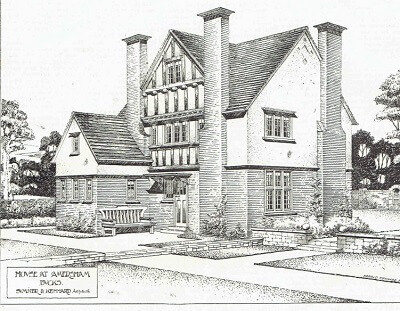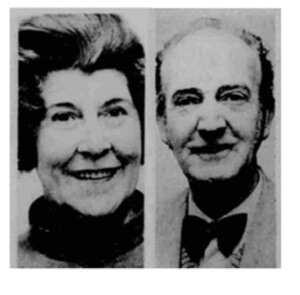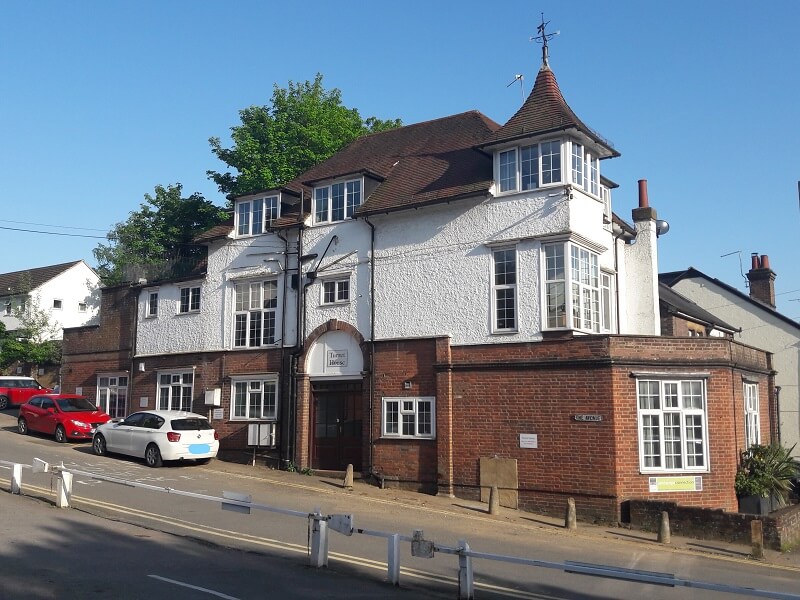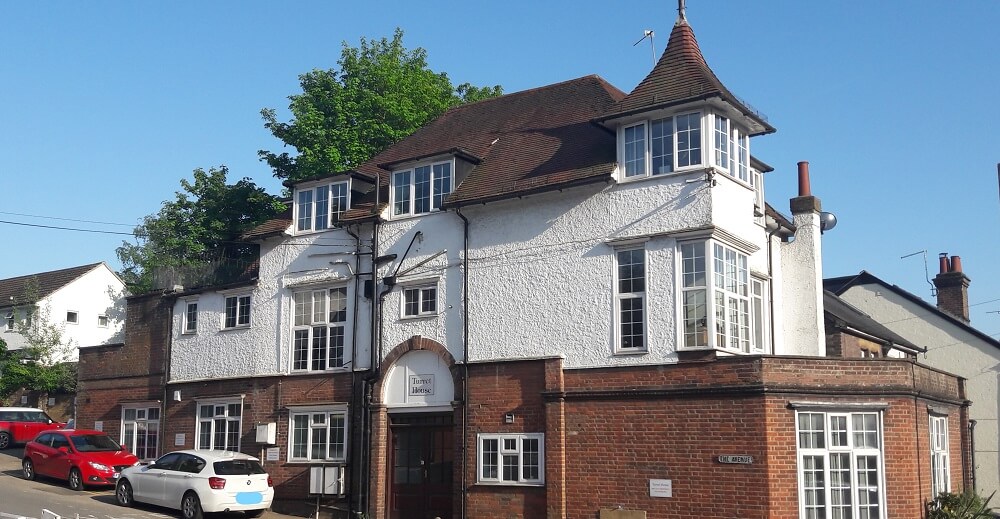Turret House
By Gwyneth Wilkie and Alison Bailey with additional research by Chris Collier and Brian Horridge
A unique local landmark, Turret House, on the corner of Station Road and The Avenue was recently divided into six flats after being used as offices since the 70s. Originally a shop, Domestic Stores, it later made a significant contribution to the cultural life of Amersham, first as a prep school, specialising in the creative and performing arts and then as a successful dance school.
Sumner and Kennard

Turret House was designed by Harold Kennard in the 1900s, as part of the Sumner and Kennard development of land immediately south of the station. It was one of the earliest developments in the new town of Amersham-on-the-Hill. Like The Avenue, Fulbeck and Station Parade, it has Kennard’s early Five Diamond Motif and Arts & Crafts style. Turret house is constructed traditionally of local red brick with pale roughcast on the first floor, under a clay tile roof. It has a distinctive square turret on the second floor which, of course, gives the building its name.
Kennard formed a partnership with William Sumner, a local businessman when he first arrived in the town as a young architect although the partnership only lasted a couple of years. Kennard became the most prolific Arts & Crafts architect and builder in Amersham before his untimely death in 1926.
Station Parade
Turret House was originally conceived as commercial premises on the ground floor with accommodation above. It was designed to be a continuation of Station Parade (which was initially its address) either side of the Avenue and like the Station Parade accommodation, included a roof terrace overlooking Station Road (then a quiet thoroughfare) with lovely views of the valley below. What is today the carpark would have been a garden.
It is celebrated as the place where solicitor Alfred Ellis, who lived at Fulbeck (then next door) founded the Amersham Free Church. The church’s first meetings were held in the large room on the ground floor before moving across to the Bijou Hall, which later became a silent cinema, then the Playhouse Theatre, and is now Amersham Auction Rooms. Ellis then commissioned his friend Harold Kennard to build the first Free Church on Sycamore Road.
Domestic Stores

The building was advertised in February 1908 as a “Commanding Corner Shop, with a 7-roomed House (the only one remaining to let on the Station Parade) suitable for light Ironmongery and Domestic Stores; handsome shop front”. From 1908 until 1923 William Sumner ran his own household and furniture business here which he called Domestic Stores, providing ‘A store at your door with everything for the home at London prices’. London prices were obviously considered a good thing then – how times change!
Residents
Upstairs, the earliest known residents were the journalists Frederick Niven, and his wife, Mary Pauline Thorne-Quelch. They lived here during WWI after Niven had been rejected for military service due to a heart condition. He spent the war working for the Ministry of Food and the War Office. He had published his first novel, The Lost Cabin Mine in 1908. Several books were written and published whilst living in Amersham including his first volume of poetry, Maple Leaf Songs, which appeared in 1917. The Nivens settled in British Columbia in 1920.
William James Barker Trundell, a shipping clerk who had been granted the Freedom of City, and his wife Dorothy Ethel were living there in 1921. Frederick Neal, a signalman on the Metropolitan Railway, was also on the electoral roll at The Turret from 1921 to 1923, whilst his wife Grace Kathleen and son Frederick William were living in one of the council houses along White Lion Road.
Turret House School 1924-1927
In 1924 Miss Kathleen Leighton opened a school in Turret House. For three years she had been Principal of Cranley Court School in Gerrards Cross, which was later incorporated into St Mary’s. Miss Leighton graduated from the Royal University of Ireland with a degree in ‘Modern Letters’. She obtained a Diploma in Phonetics from the University of Rennes at a time when that branch of science was in its infancy. She taught modern languages in many schools, including Dr Challoner’s Grammar School during WWI. She then moved back to Ireland as headmistress of the Bishop Foy School in Waterford from 1916 to 1920 before taking over Cranley Court School.
Turret House School was a prep school for boys 5 -13 and offered special attention for ‘delicate boys’. There was a playing field and a master to supervise games. Coaching was given for all public examinations such as Common Entrance, Matriculation or Teacher’s Certificate. Evening classes for adults were also run in English, Latin, conversational French and book-keeping. It claimed to be the only school in the district which catered exclusively for boys.
By 1927 it seems that Miss Leighton was having to consider a change of direction. Announcements in the Bucks Examiner show that she was intending to convert Turret House into a girls’ High School. By May she had decided to make the Girls’ High additional to the boys’ prep department. By December, however, the baton had been passed to Albert Graver, the Assistant Master at the Garden School in Ballinger.
A notice was put in the Bucks Examiner in December: “Miss Leighton, B.A., begs to announce that she has transferred The Turret House School to Mr A.J. Graver, A.C.P., who holds the Board of Education Teaching Certificate and is a Registered Teacher. Mr Graver will begin work on the 17th of January and carry on as a Boys’ Preparatory School”. Miss Leighton moved to Gilletts Lane, High Wycombe, and died in November 1941.
Albert James Graver
Albert James Graver moved to Turret House with his wife Katie, son Kenneth and young daughter Peggie. The Gravers were both musical. He taught music at the Boys’ High School in Norwich, his hometown, and then at Ongar Grammar, Clayesmore School, Winchester and Abbotsholme School.
Abbotsholme was a fee-paying school beside the river Dove in Derbyshire. Its Wikipedia entry is of considerable interest in the context of Albert Graver’s service at The Garden School and Turret House: ‘From the very beginning, the school departed from the structure of the traditional public school in favour of a less rigid environment and more liberal education. Top hats and “Eton collars” were discarded in favour of a more comfortable and practical uniform, and English, French and German were taught in place of Classics (Latin and Greek). The fine arts were introduced as core subjects, considered unusual at that time, since music and art were mostly taught at cathedral schools or specialist art institutes. Practical skills such as animal husbandry and carpentry were integrated into the curriculum.’
The Garden School
The Gravers moved to the Garden School in 1921 where Mrs Graver (from Plaistow) was also employed as Assistant Matron. The Garden school was principally for girls although it took boys until the age of 9. It moved out from London to Ballinger Grange and like Abbotsholme, offered a progressive, liberal education with great emphasis on the importance of art, crafts, music, eurythmics and a healthy outdoor life.
A notice in the Daily Herald 20 April 1932 aimed at prospective parents gives some idea of the ethos of the school:
“Will parents who believe in (1) a spiritual basis of life; (2) universal religion; (3) the need for training in world-citizenship; (4) the daily practice of internationalism; (5) the preciousness of individuality; (6) the futility of examinations in testing the growth of individual powers and gifts; (7) the joy of living (working, eating, sleeping) in the open air; write to the principal for particulars of the Garden School”.
While in Ballinger the Gravers were active in setting up two local orchestras, the first for adults, which gave its third public concert in September 1923. The birth of Peggy, ‘a new member of the orchestra…..[who] had not yet decided what instrument she was going to play and ….was at present confining herself to vocal chords’ was noted at one of the concerts in May 1925. The Gravers then brought together a junior orchestra whose attainments astonished both the local reporter and the children’s parents and by 1927 Mr Graver was also running the Ballinger String Quartet. He played a significant role in helping to set up a local examination centre for Trinity College of Music, to the benefit of many local children.
When the Gravers moved to Amersham to take over the Turret House School in 1928, the Garden School moved to Wycombe Court, Lane End.
The Turret School 1928-1947
The Gravers bought the ethos of the Garden School to Turret House for boys, introducing a kindergarten for girls and boys and a similar emphasis on music and the arts. Albert was an Associate of the College of Preceptors, a body founded in the previous century to improve academic standards in the teaching profession. He continued to teach violin, viola and cello and was a registered instructor of the National Union of School Orchestras. He was also involved with the Amersham and Chesham Music Schools.
The Turret Hall was available “at a moderate fee for Dances, Whist Drives, Concerts, Amateur Theatricals, At Homes and other functions”.
Teaching staff included “Miss M Dyer, Certificated Teacher, Pianoforte and Singing, Junior Class Mistress”. This was Katie’s sister, Mildred. Miss R Lloyd-King LGSM and Miss Elsie Field, a graduate of the Wordsworth College of Dancing gave classes in elocution and dancing. Mrs Patty Haddon, whose son John attended the school, taught music and was the accompanist during the many productions put on by the school, usually starring Peggy Graver who was a gifted musician and performer like her parents. Concerts and shows often raised funds for good causes such as the NSPCC.
Mrs Graver taught the violin but was remembered in Bob Stonnel’s memoirs We’re All In It… A Schoolboy’s War (amersham.org.uk) for her role as matron; “I graduated from the Turret kindergarten in Station Road where I had won the Bucks prize for hand writing, and distinguished myself on the Triangle. At the Turret it was the custom that before sitting down to begin the day, we were lined up round the walls, holding our little white hankies before us, like a line of washing, to be sprayed with TCP by Mrs. Graver with her Flitt-gun; she having a ‘thing’ about germs”!
Ray Wainwright was also a pupil there and shared his memories with the museum:
Unlike the Garden School which set little store by examinations, the Turret School sought to deliver the kind of success which many parents would want to see while at the same time moving away from drill and learning by rote still practised in many schools. Turret School regularly advertised successes in entrance exams to Dollar Academy, Mercers’, Berkhamsted and Merchant Taylors Schools plus Watford, High Wycombe and Amersham Grammar Schools. In 1930 Kenneth Graver, later a cellist in many local concerts, won a music scholarship to the Mercers’ School in London.
Lilian Davies introduced Margaret Morris Movement classes to the school “to ensure correct Breathing and good Posture, and to eliminate self-consciousness and develop the power of intelligent self-expression”.
Performances were reported in the local press: “An attractive demonstration of the Margaret Morris Movement was given by scholars of the Turret School, Amersham, on Tuesday afternoon, followed by the prize distribution for the work done during the year. Miss LF Davies, the Margaret Morris instructor, was in charge of the demonstration, and explained the value of the exercises, which combine physical exercise, mental alertness and graceful movement. The boys’ demonstration showed that the exercises were intended to assist athletic pursuits, while the girls took part in some very attractive movements, some of them being based on figures found on Greek vases, and give good exercise for the muscles. The junior school showed boys and girls doing the same early exercises and all three sections of the school showed that they could think for themselves when the scholars were asked to form their own exercises. The grouping arrangements were interesting, particularly the two studies of “machinery” by the boys. The girls carried out a few movements in costume, and illustrated the value of the Margaret Morris Movement in giving a sense of rhythm and form’ (Bucks Examiner, 28 July, 1939).
The End of Turret House School
During the war Lilian Davies became Principal of the school while Albert Graver continued as Headmaster. Evacuees and refugees joined the school at this time. One new pupil was Alexander Goehr, who later became a composer and academic. He was the son of German Jewish conductor and composer Walter Goehr and the talented photographer and musician Laelia Goehr. She had her first studio and darkroom in Turret House.
The school closed in 1947 for unknown reasons, and its contents were auctioned by Pretty & Ellis. Mr Graver was only 57 but may have retired due to ill health after being invalided out of the army at the end of WWI. Or, perhaps, the Gravers just wanted more time to pursue their many interests. Hefty taxation due to the war made it more difficult for parents to afford school fees and a big re-organisation of education was also looming in the form of the 1948 Education Act.
The Gravers went to live at 40 Codmore Crescent, Chesham, and he died on 29 August 1960 in Maida Vale Hospital after a short illness. Mrs Graver died on 18 May 1964 at the home of their daughter Peggy Attwood in Cambridgeshire.
Dance School

Turret House and its hall did not remain empty for long. “Amersham’s Dancing Couple” Mrs Eugenie Apolline Fabien and her husband Tony Turnidge opened the Fabien School of Dance in 1947. The Fabien Rendezvous Restaurant served fish on a Friday and afternoon tea on a Sunday. There were ballet and tap classes for children, ballroom and ‘Old Time’ dancing for adults. Miss Fabien was the first to teach Latin American dancing in Amersham and organised the first Latin American formation dance team in the area. Actress Barbara Mitchell and Z Cars star Derek Waring were taught at the school.
The building also housed a café, the Fabien Rendezvous Restaurant, run by Mrs Fox. Caroline Holland, who took part in the Museum’s 30 Stories project, took over as manager in 1965. She worked hard to build up the business as Fabien’s had a full license and was open every day, with fish served on a Friday and afternoon tea on a Sunday.
The Turnidges retired to Worthing in 1971 when Turret House was sold for office development although Miss Fabien said it was “almost heartbreaking to leave”. Yvonne Taylor Hill, a pupil of Miss Fabien from the age of four, took over the school, teaching ballet, ballroom and Latin in St Leonard’s Hall, Chesham Bois and is still teaching today.

Sources
LE Pike & C Birch, The Book of Amersham, 1976,
Julian Hunt, A History of Amersham
Literary Year Book of 1917 (p 220) lists Frederick Niven with his address as the Turret
The British Newspaper Archive
Wikipedia
Brian Horridge
Chris Collier
The Teachers’ Registration Council records [held by the Society of Genealogists and searchable through FindMyPast.co.uk
amersham.org.uk
30 Stories from the Amersham Museum
Ancestry.com

